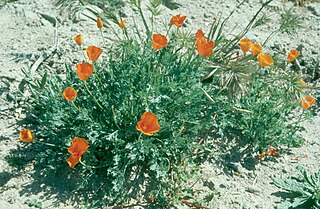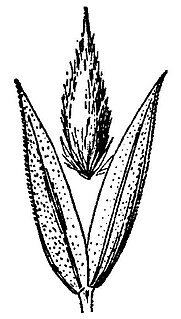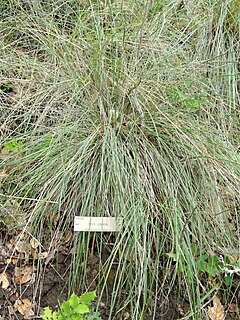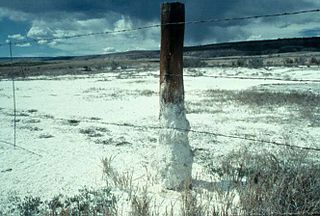
Phalaris is a genus of grasses. Various species of Phalaris grow on every continent except Antarctica. They can be found in a broad range of habitats from below sea level to thousands of feet above sea level and from wet marshy areas to dry places. P. arundinacea and P. aquatica are sometimes invasive species in wetlands.
Asarum lemmonii is a species of wild ginger which is endemic to California. It is known by the common name Lemmon's wild ginger.

Puccinellia is a genus of plants in the grass family, known as alkali grass or salt grass.

Eschscholzia lemmonii is a species of poppy known by the common name Lemmon's poppy.

Guillenia is a small genus of mustard plants containing three species. These are sometimes treated as members of the jewelflower genus Caulanthus. They are native to western North America.

Arabis lemmonii is a species of flowering plant in the mustard family known by the common name Lemmon's rockcress. It is native to western North America from Alaska to California to Colorado, where it grows in a number of rocky habitat types. This is a perennial herb growing many small stems from a branching, hairy caudex. The slender stems rest against the ground or are somewhat upright, reaching up to 20 centimeters in length. The caudex is surrounded by a rosette of hairy leaves one or two centimeters long. There are a few smaller leaves along the stem as well. The inflorescence bears pink to purple flowers which yield narrow siliques up to 4 centimeters long containing round, winged seeds.
Syntrichopappus is a genus of flowering plants in the daisy or sunflower family (Asteraceae), found in the Southwestern United States and northern Mexico, including Baja California. It is a member of the Heliantheae alliance of the Asteraceae. There are two species. Common names include xerasid and Fremont's-gold.

Phalaris lemmonii is an uncommon species of grass known by the common name Lemmon's canarygrass. It is endemic to California, where it can be found in coastal and inland mountain ranges and the Central Valley. It grows mainly in moist areas. It is an annual grass reaching maximum heights between 1.3 and 1.5 meters. The cylindrical inflorescence is up to 12 centimeters long, each spikelet made up of one strongly beaked fertile floret and one or two sterile florets.

Puccinellia distans is a species of grass known by the common names weeping alkaligrass and European alkali grass. It is native to Europe and it is present in most of North America, where it is perhaps an introduced species. It grows in moist habitat, usually in areas with saline soils, such as the edges of salted roads. It is a perennial herb producing hollow stems up to 40 to 60 centimeters in maximum height. The inflorescence is a spreading array of branches, the lower ones reflexed. The branches bear several rough-haired spikelets containing flowers.
Puccinellia howellii is a rare species of grass known by the common name Howell's alkaligrass. It is endemic to Shasta County, California, where it is known from a single population in Whiskeytown National Recreation Area near Whiskeytown and it is feared that the species may now be extinct as a result of the 2018 Carr Fire. Its entire population is contained in a 1-acre (4,000 m2) complex of three saline mineral springs directly next to Highway 299. The grass was first described to science in 1990 and no other populations were discovered despite extensive searches of the area.
Puccinellia nutkaensis is a species of grass known by the common names Nootka alkaligrass and Alaska alkali grass. It is native to North America from Alaska across northern Canada to Greenland and Nova Scotia, and down to Washington to Oregon to the Central Coast of California.

Puccinellia nuttalliana is a species of grass known by the common name Nuttall's alkaligrass. It is native to North America, where it is widespread from Alaska east throughout Canada to Greenland, and common in the western and central United States. It is present in the Arctic, throughout the temperate mountain ranges, the Great Plains, the Great Basin, and along the western coastline of North America down through California.
Puccinellia parishii is an uncommon species of grass known by the common names bog alkaligrass and Parish's alkali grass. It is native to the western United States, where it is known from a few locations in Arizona and New Mexico, and one occurrence each in California and Colorado.
Puccinellia pumila is a species of grass known by the common names dwarf akaligrass and smooth alkali grass. It is native to North America where it grows along the coastline in the northern latitudes, from Alaska across Arctic northern Canada to Greenland. It occurs on the coast of the Pacific Northwest in the United States and it is known from the Kamchatka Peninsula. The grass is only found on the coast, in wetland habitat, beaches, and areas inundated by the highest tides, in saline sand and mud. This perennial grass grows decumbent or erect to a maximum height near 40 centimeters, often remaining much smaller, especially in harsh habitat. It may root at stem nodes which become buried in wet substrate. The inflorescence is a dense or open array of branches bearing spikelets.
Puccinellia simplex is a species of grass known by the common names California alkaligrass and western alkali grass. It is native to California, where it grows in mineral springs and other moist habitat with saline soils in the Central Valley, Mojave Desert, and other areas. It is also known from Utah, but occurrences there are probably introduced. This annual grass grows up to about 25 centimeters tall. The inflorescence is generally a linear structure with parallel branches bearing small spikelets.

Silene lemmonii is a species of flowering plant in the pink family known by the common name Lemmon's catchfly.
Trifolium lemmonii is a species of clover known by the common name Lemmon's clover.

Puccinellia maritima is a species of grass known by the common names including seaside alkaligrass, common saltmarsh-grass or sea poa grass. It is native to Western Europe and it is present in most of North East North America. It grows in moist, usually saline soils. It can reach a height of 80 cm and has greyish-green leaves.

Stipa lemmonii is a species of grass known by the common name Lemmon's needlegrass. It is native to western North America, where its distribution extends from British Columbia to southern California.
Carex lemmonii, or Lemmon's sedge, is a plant in the sedge family, and is endemic to California. Carex albida is now considered a synonym, but was previously thought to be a separate species; such plants have the common name white sedge.













